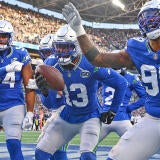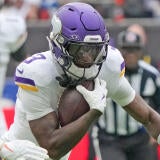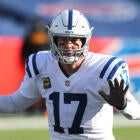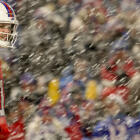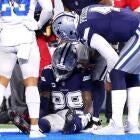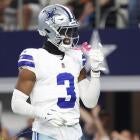
Bengals: Measuring the effect of DE Carlos Dunlap
DE Carlos Dunlap returned from a knee injury against Washington and did more than add his pass-rush ability off the edge. He made all those around him more effective.
 |
| Bengals DE Carlos Dunlap changed the shape of the Bengals defense in his return from a knee injury. (AP Images) |
The Bengals defense took a step forward Sunday. After two weeks of embarrassing miscues, flashes of the group that ranked seventh in the NFL last season showed up against Washington.
To be sure, giving up 24 points (Washington scored a defensive TD in the 38-31 Bengals victory) doesn't leave defensive coordinator Mike Zimmer skipping down the hallways of Paul Brown Stadium. It did, however, decrease his fury level a few shades of red.
Finding the difference means looking no further than the contribution of DE Carlos Dunlap. Participating in his first game of the season after missing time from a knee injury sustained in the preseason opener, Dunlap finished with one sack for 11 yards, a forced fumble and a fumble recovery. The forced turnover on Robert Griffin III deep in the Redskins' end resulted in a Cincinnati touchdown.
He changed the dynamic of the defense.
“We can pass rush better, that's for sure,” Zimmer said of having the 6-foot-6, 280-pound defensive end on the field. “He has speed, long arms, he's strong, he's pretty smart.”
The Dunlap factor delves deeper than sacks, forced fumbles or even his three QB hits. His presence makes all those around him better.
It didn't hurt that there was a backup left tackle inserted for Redskins starter Trent Williams so DE Michael Johnson could rack up three sacks and an AFC Defensive Player of the Week award, but the pressure differential was staggering.
Here's a three-week comparison of Bengals' QB hits/sacks:
Baltimore: 4/3
Cleveland: 5/2
Washington: 13/6
The signature of the 2011 Bengals defense was an eight-man rotation on the defensive line allowing everyone to stay fresh without much falloff. When Frostee Rucker bolted for Cleveland and Jon Fanene left for New England this offseason, concerns about the rotation's survival grew. When Dunlap went down and Robert Geathers nursed a knee injury, it severely dissipated. Pressure fell on rookies Devon Still, Brandon Thompson and Indianapolis castoff Jamaal Anderson to handle the extra snaps.
When Dunlap returned to play 59 percent of the snaps, quantity was traded for quality.
Player: Game 1 and 2 snap percentage/Game 3 snap percentage
Michael Johnson: 92/88
Geno Atkins: 71/79
Geathers: 66/59
Domata Peko: 66/54
Still: 36/26
Anderson: 49/IR
Brandon Thompson: 10/Inactive
Wallace Gilberry: N/A/24
- The snaps previously given to Anderson, who managed but one QB hit through 61 reps the first two games, transferred to Dunlap, who hit the speedy RG3 three times Sunday.
- Pressure relieved from veterans Geathers, Peko and rookie Still, who all saw their snaps decreased. Plus, rookie third-round pick Thompson was left inactive.
- What shouldn't be lost is the addition of Gilberry, who added 18 snaps spelling Peko and Atkins on the inside while also adding a breather occasionally for players on the edges.
Perhaps more than any snap differential or extra pressure, what matters is when Dunlap brings what he does best. When leading late in the game and the other team is driving to even the score, few tee off better than the fourth-year pro from Florida.
“You really can't coach that,” Johnson said.
With first and 10 from the Cincinnati 19 late in the game, Dunlap brutalized Washington RT Tyler Polumbus into the backfield and grabbed ahold of RG3. As the disoriented QB spun out of the attempts, Atkins cleaned up the mess in a 15-yard loss. For all intents and purposes, the game was over.
Coming off injury or not, Dunlap wasn't missing that opportunity.
“The game's on the line,” Dunlap said. “I didn't want to come out. I want to be like the closer and be that guy my teammates can count on when they need that big play.”
Follow Paul Dehner Jr. for Bengals updates on Twitter at @CBSBengals.





